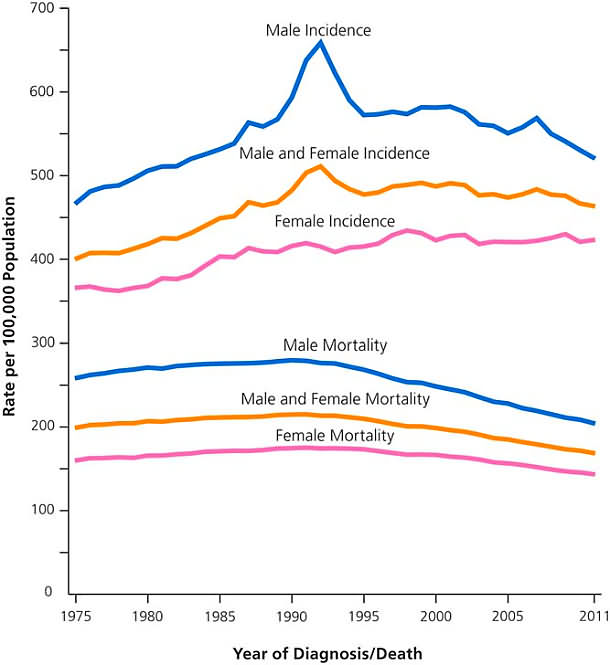Each year the American Cancer Society estimates the numbers of new cancer cases and deaths that will occur in the United States in the current year and compiles the most recent data on cancer incidence, mortality, and survival. Incidence data were collected by the National Cancer Institute (Surveillance, Epidemiology, and End Results [SEER] Program), the Centers for Disease Control and Prevention (National Program of Cancer Registries), and the North American Association of Central Cancer Registries. Mortality data were collected by the National Center for Health Statistics. A total of 1,658,370 new cancer cases and 589,430 cancer deaths are projected to occur in the United States in 2015. During the most recent 5 years for which there are data (2007-2011), delay-adjusted cancer incidence rates (13 oldest SEER registries) declined by 1.8% per year in men and were stable in women, while cancer death rates nationwide decreased by 1.8% per year in men and by 1.4% per year in women. The overall cancer death rate decreased from 215.1 (per 100,000 population) in 1991 to 168.7 in 2011, a total relative decline of 22%. However, the magnitude of the decline varied by state, and was generally lowest in the South (�15%) and highest in the Northeast (�20%). For example, there were declines of 25% to 30% in Maryland, New Jersey, Massachusetts, New York, and Delaware, which collectively averted 29,000 cancer deaths in 2011 as a result of this progress. Further gains can be accelerated by applying existing cancer control knowledge across all segments of the population. CA Cancer J Clin 2015;000:000
000. V2015 American Cancer Society.
Keywords: cancer statistics, incidence, trends, survival, mortality, death rates, cancer cases
Introduction
Cancer is a major public health problem in the United States and many other parts of the world. It is currently the second leading cause of death in the United States, and is expected to surpass heart diseases as the leading cause of death in the next few years. In this article, we provide the expected numbers of new cancer cases and deaths in 2015 in the United States nationally and for each state, as well as a comprehensive overview of cancer incidence, mortality, and survival rates and trends using the most current population-based data. In addition, we estimate the total number of deaths averted nationally during the past 2 decades and by state in 2011 as a result of the continual decline in cancer death rates. We also present the actual number of deaths reported in 2011 by age for the 10 leading causes of death and for the 5 leading causes of cancer death.
Materials and Methods
Incidence and Mortality Data
Mortality data from 1930 to 2011 were obtained from the National Center for Health Statistics (NCHS).1 Forty-seven states and the District of Columbia met data quality requirements for reporting to the national vital statistics system in 1930. Texas, Alaska, and Hawaii began reporting mortality data in 1933, 1959, and 1960, respectively. The methods for abstraction and age adjustment of mortality data are described elsewhere.2,3
Population-based cancer incidence data in the United States have been collected by the National Cancer Institute’s (NCI’s) Surveillance, Epidemiology, and End Results (SEER) Program since 1973 and by the Centers for Disease Control and Prevention’s National Program of Cancer Registries (NPCR) since 1995. The SEER program is the only source for long-term, delay-adjusted, population-based incidence data. Long-term incidence and survival trends (1975-2011) were based on data from the 9 oldest SEER areas (Connecticut, Hawaii, Iowa, New Mexico, Utah, and the metropolitan areas of Atlanta, Detroit, San Francisco-Oakland, and Seattle-Puget Sound), representing approximately 9% of the US population.4
1Director, Surveillance Information, Surveillance and Health Services Research, American Cancer Society, Atlanta, GA; 2Epidemiologist, Surveillance and Health Services Research, American Cancer Society, Atlanta, GA; 3Vice President, Surveillance and Health Services Research, American Cancer Society, Atlanta, GA
Corresponding author: Rebecca L. Siegel, MPH, Surveillance and Health Services Research, American Cancer Society, 250 Williams St, NW, Atlanta, GA 30303-1002; Rebecca.siegel@cancer.org
DISCLOSURES: The authors report no conflicts of interest.


来自美国癌症协会(ACS)的年度统计数据报告显示,在美国癌症死亡率已经从1991年的高峰下降了22%。这相当于超过150万例癌症死亡可以避免。医脉通对相关内容整理编译,详情如下:
《2015癌症统计》发表在美国癌症协会期刊《CA:一本面向临床医师的癌症杂志》上,和它的姊妹篇《癌症事实&数字,2015》,文中预计了今年美国新的癌症病例数量和新增癌症人数。这一评估是世界范围内最广泛引用的癌症统计数据。
2015美国年预期会出现1658370例新的癌症病例,同时有589430例癌症死亡病例。在最近有统计数据的5年(2007-2011),男性新发癌症病例每年下降1.8%,女性维持一样。在同样的5年,男性癌症死亡率每年下降1.8%,女性为1.4%。
“我们发现癌症死亡率持续下降是值得庆祝的,但是不能停止,”John R.Seffrin教授(美国癌症协会首席执行官)在一份声明中说。“在2011年癌症占据了美国近四分之一的死亡,使它从整体上成为死亡的第二大病因。在年龄40~79的成年人中,癌症是死亡的最主要原因,而且有超过心脏疾病的趋势,在未来几年成为所有美国人死亡的主要原因。这种变化或许不可避免,但是我们仍然可以确保尽可能多的美国人通过使用预防,检测,和治疗癌症的最佳工具,降低癌症的致命影响。”
研究人员说,更多的进步可以通过社会各阶层的抗癌努力获得。癌症死亡数量的下降各个州有所不同,南方最低,东北最高。在癌症死亡率和趋势的地区差异反映了风险因素模式的差异,例如吸烟,肥胖,以及国家贫困分布差距,医疗保健情况,这些会随着时间增加。
肺癌,结肠癌,前列腺癌和乳腺癌
※ 肺癌,结肠癌,前列腺癌和乳腺癌仍然是癌症死亡的最常见原因,占据了男性和女性总体癌症死亡的几乎一半。每4例癌症死亡中多于1例是由于肺癌。
※ 由于减少了烟草的使用,1990年到2011年之间男性肺癌死亡率下降了36%,2002年到2011年之间女性肺癌死亡率下降11%。肺癌发病率在男性中于20世纪80年代中期开始下降,女性是在20世纪90年代末期。这一差异反映了烟草使用的历史模式,女性开始吸烟大约比男性稍晚20年。
※ 乳腺癌死亡率降低超过了峰值的三分之一(35%)多,而由于早期检测和治疗提高的结果,前列腺癌和结肠癌死亡率每一种降低了几乎一半(47%)。
※ 2015年,前列腺癌,肺癌和结肠癌将占男性所有癌种的大约一半,其中仅前列腺癌就占了新诊断的约四分之一。
※ 2015年女性最常见的三种癌症类型预估是乳腺癌,肺癌,和结肠癌,占据了女性所有病例的几乎一半。仅乳腺癌预期在美国女性新的癌症病例中约有29%。
原位乳腺癌的专门章节
每年,美国癌症协会的研究人员在《癌症事实&数字》中会包括一个专门章节,强调癌症研究或者治疗的话题。今年的主题是原位乳腺癌。在2015年诊断出的原位乳腺癌预估新增病例有60290例。原位乳腺癌并不像浸润性乳腺癌被人们广为了解。
原位癌描述为异常细胞尚未浸入附近组织,但是外观在显微镜下看上去与癌细胞非常相似。很多年来,人们认为这些细胞如果不治疗的话最终将成为浸润性癌。但是最近的研究表明这一过程要比想象的更为复杂,长期研究已经发现即使不治疗,不是所有的原位癌病例都会变为侵润性癌。
绝大多数原位乳腺癌(83%)是导管原位癌(DCIS)。DCIS在乳腺管壁层细胞开始。尽管DCIS不能扩散到身体的其他部位,或者引起严重疾病或死亡,如果不能及时治疗它可能成为浸润性癌。研究已经发现20%~50%未经治疗的DCIS女性最终诊断为浸润性乳腺癌。另一方面,某些女性接受DCIS治疗或许从未进展为浸润性乳腺癌。不幸的是,目前还没有某种好的方法知道哪种病例会继续成为浸润性癌,哪些不会。
小叶原位癌(LCIS)开始于乳房产奶腺体。LCIS一般不会被认为是浸润性癌的前体,但会视为进展为增加浸润性乳腺癌的风险的一个标志。
文章作者说他们希望在专门章节的信息将会帮助患者及其家庭面对疾病,为新近诊断和那些DCIS或者LCIS诊断后继续生活的女性提供支持和帮助。
医脉通编译自:Facts & Figures Report:1.5 Million Cancer Deaths Avoided in 2 Decades,www.cancer.org,December 31,2014




